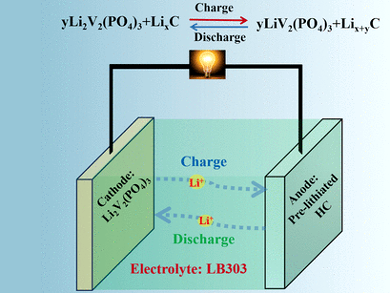Poor Low-Temperature Performance of Lithium-Ion Batteries
When it is cold in winter, cars tend to have starting problems. This is not much better with electric cars, which inevitably lose capacity of their rechargeable lithium-ion batteries at freezing temperatures. Now, Chinese scientists have offered a strategy to avoid plunging battery kinetics. They have designed a battery system with a cold-enduring hard-carbon anode and a powerful lithium-rich cathode, with the important initial lithiation step integrated.
“Non-graphitizable” or “hard” carbon is a promising, low-cost anode material in battery technology. Even at low temperatures, it exhibits fast intercalation kinetics of lithium ions. During charging/discharging of a battery cell, lithium ions migrate from the cathode through an electrolyte to the anode and vice versa. If the anodic material, which is often graphite, contains prestored lithium, the volume change by the incoming lithium ions is leveled out to ensure a longer cell life and faster charge/discharge kinetics. Prelithiated hard carbon has been proven as a robust material in lithium-ion capacitors. However, the prelithiation process, which involves a pure lithium electrode, is complicated and expensive. Alternative prelithiation strategies are therefore favored by Yonggang Wang and his team at Fudan University, Shanghai, China.
Lithium-Rich Vanadium Phosphate Electrode and Hard Carbon Anode
Instead of the extra lithium electrode, the team introduced a lithium-rich vanadium phosphate electrode both for lithiation and normal battery operation. The cathode loses some of its lithium ions to the anode in the first charging process where they are intercalated and stored. Then, the scientists combined the lithium-reduced vanadium phosphate cathode and the prelithiated hard-carbon anode (LixC) to form a working lithium-ion battery system. This full cell “keeps the high energy density characteristics of conventional lithium-ion batteries and exhibits the supercapacitor-like high power and long cycle life,” the scientists explained. Moreover, it keeps about two-thirds of its capacity at temperatures as low as minus 40 °C. Conventional lithium-ion batteries retain only 10 %.
“This achievement arises from the inherent low-temperature ability of the vanadium phosphate cathode and the fast kinetics of the prelithiated hard-carbon anode,” said the researchers. Many further tests showed that these batteries fulfilled the other parameters of electrochemical cells.
A flaw, still, is the electrolyte that loses conductivity under extremely cold conditions. If this point is solved, this system might provide an attractive design for best performance, winter-enduring electric car engines.
- A Simple Prelithiation Strategy To Build a High-Rate and Long-Life Lithium-Ion Battery with Improved Low-Temperature Performance,
Yao Liu, Bingchang Yang, Xiaoli Dong, Yonggang Wang, Yongyao Xia,
Angew. Chem. Int. Ed. 2017.
https://doi.org/10.1002/anie.201710555


